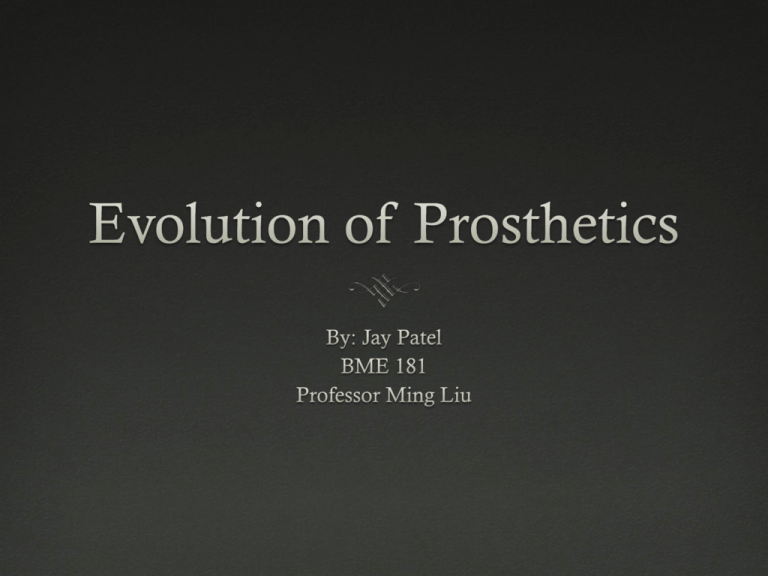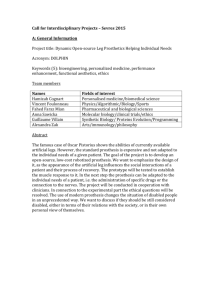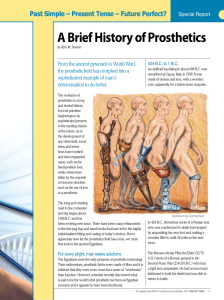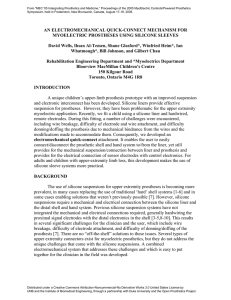History of Prosthetics
advertisement

What Are Prosthetics? Prosthetics are artificial limbs or body parts, that replace missing or malfunctioning body parts Most common prosthesis are the leg and arm, and more recently also heart valves Prosthetic Leg & Arm The Beginning Around 1500 B.C. was the time when “prosthetics” were “engineered” Were not functional Only purpose was to help with movement Were generally made of wood The Push Towards Modern Prosthetics In the mid 1800s, Sir James Syme discovered a way to amputate at the thigh This meant that there was a possibility of walking again Both World Wars were key in the developmental progress of prosthetics Parts used in prosthetics were introduced from various fields Design Breakthroughs In the early 1800s, James Potts designed the first wooden functional prosthetic foot, which was controlled by tendons from the knee to the foot In the mid 1900s, prosthetics now had a endo-skeletal design instead of a exo-skeletal This allowed the hard shell-like exterior to be replaced with a foam cover, so the weight and force was applied to the ‘core’ of the prosthetic rather than the exterior Evolution Basic Prosthetics Today Cosmetic Prosthetics ($) 1– Generally for upper limb amputation, low to no functionality, made from PVC or silicone Body-Powered Prosthetics ($$) 2– Generally for upper limb amputation, limited amount of functionality provided by muscles in the relative area Myoelectric Prosthesis Are more complex then some of the other prosthesis on the market Can reach over the head, down by the feet, and out to the sides of the body Many tests must be conducted to make sure it is suitable Internal Components: electrodes, battery pack, control unit (processing), motors, and sensors Myoelectric Prosthesis Is an externally powered prosthesis that uses electromyography (EMG) signals from voluntarily contracted muscles in the residual limb for movement Electrode sensors are embedded in the prosthetic’s socket to make contact with the surface of the skin Things to Consider Functional prosthetics are available, however there is a still room for improvement There is a high cost for fully functional prosthesis Human vs. machine – where is the line drawn? References Gutfleisch, O. (2003). Peg Legs and Bionic Limbs: The Development of Lower Extremity Prosthetics. Interdisciplinary Science Reviews, 28(2), 139-148. http://dx.doi.org/10.1179/030801803225010368 Lam, S. (n.d.). Types of Prosthesis. Retrieved March 21, 2013, from Myoelectric Prosthesis website: http://bme240.eng.uci.edu/students/10s/slam5/types.html Norton, K. M. (2007, November/December). A Brief History of Prosthetics. inMotion, 17(7). Retrieved from http://www.amputeecoalition.org/inmotion/nov_dec_07/history_prosthetics.html Peerdeman, B., Boere, D., Witteveen, H., Huis in't Veld, R., Hermens, H., Stramigioli, S., . . . Misra, S. (n.d.). Myoelectric Forearm Prostheses: State of the Art From A Usercentered Perspective. Journal of Rehabilitation Research & Development, 48(6), 719-737. doi:10.1682/JRRD.2010.08.0161 Prosthetics of Future Will Mesh Body, Mind and Machine. (2005, October 26). Retrieved March 21, 2013, from United States Department of Veterans Affairs website: http://www.research.va.gov/news/features/prosthetics.cfm#.UHY8kyKsGCQ Wikipedia. http://en.wikipedia.org/wiki/Prosthesis March 23, 2013. Google Images. http://www.google.com/images March 21, 2013.










